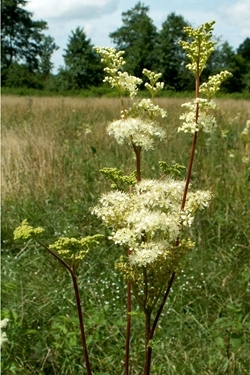Meadowsweet
 My favourite local river meadow walk has recently turned into an experience bordering on olfactory assault, with the scent of heavily perfumed invasive Himalayan balsam, mounds of flowering water-mint and tall sprays of meadowsweet filling my nose as I walk. I have chosen the latter as my subject because, unbeknownst to me before I researched it, meadowsweet (Filipendula ulmaria) has a wonderful history in folklore and a whole catalogue of practical and herbal uses.
My favourite local river meadow walk has recently turned into an experience bordering on olfactory assault, with the scent of heavily perfumed invasive Himalayan balsam, mounds of flowering water-mint and tall sprays of meadowsweet filling my nose as I walk. I have chosen the latter as my subject because, unbeknownst to me before I researched it, meadowsweet (Filipendula ulmaria) has a wonderful history in folklore and a whole catalogue of practical and herbal uses.
Meadowsweet is a tall, robust herb from the rose family that grows in damp soil on grassland and river banks where the water levels fluctuate. It’s not difficult to find – look for a big spray of frothy white flowers from June to September, atop green-to-reddish stems with paired, serrated leaflets.
The little individual flowers grow in dense clusters and have very long stamens, giving the flowerheads a fuzzy candy-floss appearance. They have a wonderful fragrance somewhere between wild privet, musk and almond.
Meadowsweet is the food plant for lots of species of moth caterpillars, and the flowers are visited by many other invertebrates including bees, hoverflies and ladybirds. Once pollinated, each flower develops into a globular fruit with spiral grooves, looking like a little clasped hand. The plant is perennial, spending the winter as a rosette before bursting forth with fresh tall growth in the following year.
The pile of literature about meadowsweet in folklore and herbal medicine stacks pretty high. Let’s start with some insights to the name – firstly, it comes from the Anglo-Saxon ‘meodu-swete’, meaning ‘mead sweetener’, because it was used to flavour drinks for centuries.
In Chaucer’s day it was known as meadwort, and it was also called bridewort after the practice of strewing it about in churches for weddings. It was very popular as a strewing herb generally, even for Queen Elizabeth I, who ordered that it be used instead of straw on her chamber floors!
The most amusing, though, has to be the old Yorkshire nickname of ‘courtship and matrimony’. Courtship refers to the seductive sweetness of the flowers. Matrimony refers to the less pleasant antiseptic smell of the plant when crushed, giving you a very cynical metaphor of marriage!
There is a good reason for the antiseptic smell. Meadowsweet contains salicyclic acid, the ingredient in aspirin. Despite being more famously associated with willow, this anti-inflammatory drug was named after meadowsweet’s old botanical name of Spiraea ulmaria. It’s also easier on the stomach than aspirin, because of the softening effect of other compounds within the plant.
No surprise then, that a tea made from meadowsweet was the go-to herbal medicine to treat many ailments in the days before aspirin was synthesised. It helps rheumatism, gout, headaches, fever and digestive issues. Next time you have one-too-many espresso martinis, sort your hangover out with meadowsweet tea!
If you’re not sensitive to aspirin, you can try making any number of culinary delights, because meadowsweet can be used in almost any recipe that uses elderflower. Steep the flowers to flavour cordials, custard, ice cream and home brews. I, for one, will be trying out meadowsweet rice pudding, Turkish delight and champagne!
And finally, to some rather far-fetched mythical qualities of meadowsweet. Along with vervain and water-mint, meadowsweet was apparently one of the three most sacred herbs of the druids. Some of them used it to identify thieves! If you have had something stolen recently, try this: gather a sprig of flowers and drop it in water – if it sinks, the culprit was a man, and if it floats it was a woman. I appreciate this may not narrow it down too much, so you might need to call the police regardless.
And if I have not yet quite convinced you of the merits of meadowsweet, one book on wildflowers in folklore claims that “the sweet scent has the power to grant second sight, and an ability to converse with the fairies.” What more can you ask for!
Jess Brooks
Advisory
Photo credit: Krzysztof Ziarnek